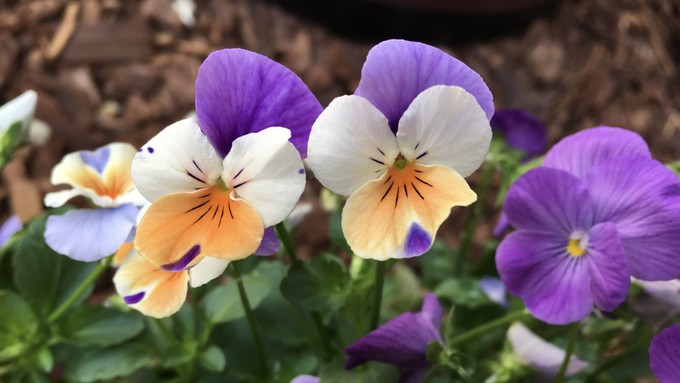
Chilly nights follow clear days; watch for frost

Transplant violas now for cheery color in winter and early spring gardens. Kathy Morrison
Get ready for chilly nights! Now that our spate of storms have passed through, Sacramento can expect a week full of mostly clear skies.
But without cloud cover, our overnight lows are going to dip way down. We’ll be flirting with frost all week.
According to the National Weather Service, Sacramento could get down to 31 degrees in the wee hours of Saturday night. Overnight lows of 33 are forecast for Sunday and Tuesday with patchy areas of frost predicted for every day but warmer than normal, with afternoon highs of 58 degrees forecast for Monday, Wednesday, Thursday and Friday. High-low averages for January in Sacramento: 54 and 39 degrees.
With no rain in the forecast for at least another week, we have a chance to dry out – and get to work.
* Keep frost cloths handy and protect sensitive plants. Make sure to remove cloths during the day.
* Don’t turn on the sprinklers for at least another week. The soil is plenty saturated already.
* Note areas of your landscape where water continued to stand long after the rain stopped. That ground likely needs amendments to improve soil drainage.
* Prune, prune, prune. Now is the time to cut back most deciduous trees and shrubs. The exceptions are spring-flowering shrubs such as lilacs.
* Now is the time to prune fruit trees. Clean up leaves and debris around the trees to prevent the spread of disease.
* Prune roses, even if they’re still trying to bloom. Strip off any remaining leaves, so the bush will be able to put out new growth in early spring.
* Clean up leaves and debris around your newly pruned roses and shrubs. Put down fresh mulch or bark to keep roots cozy.
* Apply horticultural oil to fruit trees soon after a rain to control scale, mites and aphids. Oils need 24 hours of dry weather after application to be effective.
* This is also the time to spray a copper-based oil to peach and nectarine trees to fight leaf curl.
* Divide daylilies, Shasta daisies and other perennials.
* Cut back and divide chrysanthemums.
* Plant bare-root roses, trees and shrubs.
* Transplant pansies, violas, calendulas, English daisies, snapdragons and fairy primroses.
* In the vegetable garden, plant fava beans, head lettuce, mustard, onion sets, radicchio and radishes.
* Plant bare-root asparagus and root divisions of rhubarb.
* In the bulb department, plant callas, anemones, ranunculus and gladioli for bloom from late spring into summer.
* Plant blooming azaleas, camellias and rhododendrons. If you’re shopping for these beautiful landscape plants, you can now find them in full flower at local nurseries.
Comments
0 comments have been posted.Sacramento Digs Gardening to your inbox.
Sites We Like
Garden Checklist for week of July 21
Your garden needs you!
* Keep your vegetable garden watered, mulched and weeded. Water before 8 a.m. to reduce the chance of fungal infection and to conserve moisture.
* Feed vegetable plants bone meal, rock phosphate or other fertilizers high in phosphate to stimulate more blooms and fruiting. (But wait until daily high temperatures drop out of the 100s.)
* Don’t let tomatoes wilt or dry out completely. Give tomatoes a deep watering two to three times a week.
* Harvest vegetables promptly to encourage plants to produce more. Squash especially tends to grow rapidly in hot weather. Keep an eye on zucchini.
* Pinch back chrysanthemums for bushy plants and more flowers in September.
* Remove spent flowers from roses, daylilies and other bloomers as they finish flowering.
* Pinch off blooms from basil so the plant will grow more leaves.
* Cut back lavender after flowering to promote a second bloom.
* It's not too late to add a splash of color. Plant petunias, snapdragons, zinnias and marigolds.
* From seed, plant corn, pumpkins, radishes, winter squash and sunflowers.